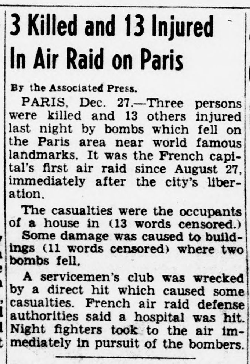
|
continued … Paris had one raid still to undergo, on 26 December 1944. Author Peter Taghon was able to obtain the account of Obltn. Ernst Wannemacher, Staffelkapitän of 4./LG 1, who flew one of the Ju 88 A-4 assigned to the attack. He recalled being briefed to bomb the Hôtel Ritz on the Place Vendôme, supposedly an important HQ where Eisenhower, Montgomery and Churchill were conferring. (As could be read in that day's Völkischer Beobachter, Churchill was actually in Athens at the time). Wannemacher recalled studying new reconnaissance photos, but it is unclear who might have taken any (the Arado 234s of Kdo. Sperling do not seem to have been near the city since early in October for example). Carrying a full load of fuel, two SC 1200 Trialen bombs and war reporter Hanns Gross, Wannemacher set off from Ahlhorn at 19.49 GMT, touching down at Münster-Handorf to receive more photos of the target before resuming his flight to Paris at low altitude. The Allied Y-Service heard one or more aircraft of LG 1 in contact with Handorf from 20.19–20.44 GMT. As he recalled it, five Ju 88 had been assigned but two turned back with technical difficulties. Conversely, a orders from II. Jagdkorps at 13.00 that day had stated that the main body of LG 1 and I./KG 66 was to attack the Namur-Flawinne marshalling yards while three machines would fly Unternehmen »R«. When the message was deciphered, around midnight, British analysts commented “R: meaning not known” but with hindsight it may have meant “Ritz”. No Flak warnings relating to this mission were picked up. Wannemacher found that towns and villages en route were not observing any black-out and that Paris itself was brightly lit, as were neighbouring airfields. He overflew the target area twice and, despite some haze, was able to recognise his target on the second pass. He released his bombs in a dive and believed they fell close to the hotel. With the first explosions, all the city lights went out, searchlights came on and the Ju 88 turned for home. Bad weather meant seeking out an airfield in Southern Germany and they took a hit from AA near Saarbrücken. Eventually, they were able to get down at Groß-Sachsenheim at 23.32, minus a square metre of one wing and an antenna; in addition the Junkers’ fin was buckled. The attacks missed the deadline for the next day’s papers but some heavily-censored reports appeared on the 28th. The HQ of the 9th US Air Force announces that two hostile aircraft dropped bombs on the Paris area, shortly after 23.00 last night. Anti-aircraft guns engaged the machines while they were over the city. There were some fatalities and numerous injured people were taken to various Parisian hospitals. The all-clear was sounded at 23.15. (Çe Soir) At the time of going to press it was still only possible for the Paris dailies to bring you more about Tuesday night’s air raid than appeared in yesterday’s New York Herald Tribune and in a seven-line communiqué from HQ 9th US Air Force. This communiqué makes it known that “two enemy aircraft” dropped bombs in the Paris area shortly after 23.00 on Tuesday. For its part, the New York Herald reports that one bomb fell on a soldiers’ club, damaging the building and that there were some casualties. Information gathered by Combat allows us to say that the injured were taken to the Marmottan Hospital and that some buildings were damaged by material thrown up from the explosion of the bombs. Thanks to the censors’ vigilance, German radio will more easily be able to spread false reports if it thinks it necessary. (Combat) France-Soir’s report was a little different, saying that the Prefect of Police had visited the sites where the bombs had fallen, that only one aircraft had been involved, and that American ambulances had take away the casualties. The Franc-Tireur had more: The day before yesterday, two enemy aircraft were able to get past Allied AA and fighters and drop some bombs on Paris. Material damage was quite significant, especially in an auxiliary hospital where, fortunately, there were no casualties. The German planes flew over the Senlis area [NE of Paris]. The alert was given a little late, coming as the first bomb fell. In America, the Washington Evening Star carried an Associated Press report that three people had been killed and 13 injured by bombs which fell “near world famous landmarks”. Some of the casualties had been occupants of a house in “(13 words censored)” while two bombs had damaged buildings “(11 words censored)” and a servicemen’s club had been wrecked by a direct hit “which caused some casualties”.
Reviewing the month, Supreme Headquarters Allied Expeditionary Forces noted of the night 26/27 December: … 150 night fighters and 60 bombers made widespread attacks throughout the army Group area and also in the Communications Zone, a few bombs being dropped on Paris, Maastricht, Liège, Dinant, Huy and Namur (where the bridge was twice hit) … continued on next page …
|
|||||
PART FOUR OF FIVE |
||||||
 |
||||||
The report of the attack carried by the Washington Evening Star. |
||||||
